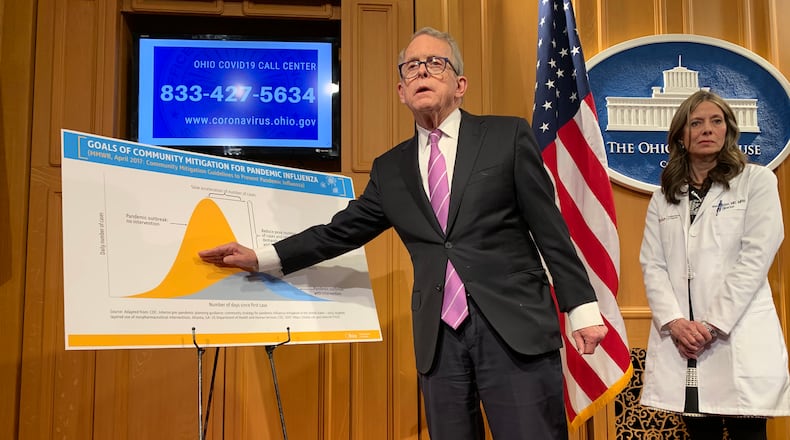DeWine said after seeing photos of packed bars over the weekend and considering the upcoming St. Patrick’s Day, he decided the order was needed to force social distancing, the practice of avoiding crowds and staying at least six feet away from others.
“It is very drastic action but we are taking these steps to save lives,” DeWine said.
Carry out food will still be allowed, under the order signed by Ohio Department of Health Director Amy Acton. The governor said it’ll be in force as long as necessary.
Local restaurants, bars prepare for changes
The announcement of the forced shutdown left some Dayton-area restaurant owners stunned and conflicted.
Shanon Morgan, executive director of the Miami Valley Restaurant Association, said, “I agree that it is better to be proactive than reactive, but it’s such a hard situation. Of course, all the owners want to do what is best for their employees and guests, but this is their livelihood. It’s such a hard decision with no good choices.”
MacKenzie Manley, founder and owner of Mack’s Tavern in Washington Twp., said a forced closure “will devastate all my employees.
“I’m worried about Mack’s and myself, sure … but my employees, that is who I am shedding tears over. … “What are they going to do? This is so crazy. Shutting down bars and restaurants will hurt so many families so bad.
“They are the ones with no backup, since they work for small businesses. You can say that it’s ‘only for a few weeks,’ but most tipped employees live day to day. So even one day closed will hurt them so much. It will be devastating, is all I can say.”
Dan Apolito, co-founder of the two Archer’s Tavern locations in Centerville and Kettering and of Stone House Tavern in Waynesville, said he and his management team “focusing our energy on helping all of our team members access any unemployment benefits available through the state and doing our best to help them navigate these uncertain times.”
Teresa Geraci, co-owner of Beavercreek Pizza Dive in Beavercreek, said closing dine-ins while allowing restaurants to provide carryout and delivery will likely help accomplish the goal of limiting large gatherings while allowing restaurants to continue to operate, and to retain staff while maintaining food safety.
Dozens of Dayton-area restaurants used Facebook and social media Sunday afternoon and Sunday night to let potential customers know of their plans to offer carryout, delivery, and curbside service. You can find out what local restaurants are offering at Dayton.com
>> Coronavirus: List of business closures
Schools, parents prepare for schools to close long-term
Ohio’s schools may have to remain closed for the remainder of the school year due to the coronavirus outbreak, Gov. DeWine said Sunday in an interview with CNN.
DeWine last week ordered all Ohio K-12 schools to shut down for three weeks starting today.
Local parents are bracing for weeks of uncertainty.
Angela Worley has a 13-year-old at Stivers School for the Arts and is herself a substitute teacher at Dayton Public Schools.
“I have zero income right now,” she said. “I can’t go out and get a new job. This is devastating for me.”
Worley said parents she talks to are overwhelmed. They are suddenly trying to figure out childcare. Some don’t have the technology at home for the remote learning the district has planned. Those that do are being asked to oversee their children’s education at home with no training about how to do so.
“They’re concerned about how they’re going to stay on top of their children’s homework,” she said.
Meanwhile parents are losing income because of cuts to hours or loss of customers at work. And they’re dealing with the same stress as everyone else about their family’s health because of the virus.
Worley worries most about the children whose families have fewer resources. She said teachers shed tears at the end of the day Friday.
“We see these kids every day.During a normal circumstance they come to school hungry and they’ll tell you the last time they ate was yesterday when they were at school,” she said.
Dayton Public Schools has announced itsintention to continue providing free breakfast and lunch during the break. But it’s unclear how they are going to deliver the food to homes that don’t have transportation. They are asking for community volunteers to help with this effort.
DPS School Board President Mohammed Al-Hamdani said in an interview Sunday that an extended, forced closure would present numerous challenges for the district. For one, remote learning is no substitution to having kids in classrooms with teachers.
“Kids not going to school for a long period of time means they fall behind,” he said.
The students will miss out on more than academics. In addition to food, schools provide physical and mental health services, social interaction, structure and more.
“There’s a lot of families that depend on a whole lot of services from us, not just education,” he said.
He said the district is still figuring out how to deliver these services. “We’re all trying to figure out the new reality in America,” he said.
>> Coronavirus: Complete coverage
New limits on hospital visitation
In another coronavirus-related development, the Greater Dayton Area Hospital Association announced Sunday that visitors to acute-care hospitals will be restricted starting today, March 16, to help slow the spread of the virus.
The restrictions include:
- No visitors under the age of 14;
- No visitation by anyone with symptoms of the seasonal flu or coronavirus including shortness of breath, coughing, fever, chills, headache, vomiting, sore throat, muscle aches or diarrhea;
- Patients will be allowed one visitor per day. Visitation will only be allowed by spouses, significant others, parents or legal guardians. (Patients of Dayton Children’s Hospital will be allowed two parents or guardians per day);
- Emergency department patients may have one support person.;
- Obstetrics patients may have one partner and one birth-support person;
- Patients requiring assistance due to mobility, interpretation or health-care decision-making may have one additional assistance person.
- When visiting a patient, visitors will be asked to primarily remain in the room with the patient.
- There are exceptions for special circumstances, especially end-of-life situations.
Affected hospitals include: Atrium Medical Center, Dayton Children’s, Dayton-Springfield Emergency Center, Grandview Medical Center, Greene Memorial Hospital, Indu and Raj Soin Medical Center, Joint Township District Memorial, Kettering Health Network — Troy Hospital, Kettering Heath Network Middletown, Kettering Medical Center, Mercy Memorial – Urbana, Miami Valley Hospital, Miami Valley Hospital North, Miami Valley Hospital South, Southview Medical Center, Springfield Regional Medical Center, Sycamore Medical Center, Upper Valley Medical Center, Wayne Health Care, Wilson Health, and WPAFB 88th Medical Center.
Cases in Ohio now up to 36
The number of confirmed cases grew to 36 in Ohio, plus 350 more have been tested but the results are still pending, according to the Ohio Department of Health.
The closest confirmed cases to the Dayton area are six in West Chester Twp. in Butler County.
Ohio Department of Health Director Acton urged Ohioans not to focus on the number of confirmed cases. Instead, look at how the pandemic has played out in other countries, including Italy which just closed its churches — a move not made even during the Black Plague, she said.
There will be “multiple Wuhans in this country” as cities see surges of cases and up to 70% of the population becomes infected, she said. In a moderate outbreak, 200,000 intensive care beds will be needed nationwide, though only 45,000 ICU beds exist and 60% to 80% are occupied. And without interventions, as many as 740,000 ventilator would be needed — far more than the 160,000 on hand across the nation, Acton said.
“This is the real thing. This is not a drill. This is a once in a lifetime pandemic and everything that each of us does matters,” Dr. Acton said, in urging Ohioans to practice social distancing and avoid all non-essential activities.
Dr. Acton also warned that Ohio’s nurses and doctors need to stay healthy so they can care for the ill. She noted that hospitals will likely open on-site daycare centers so their personnel can continue working.
“Nobody alive has seen anything like this. It’s understandable that it is taking, not just people in Ohio but people across the country, a while to get their head around this. They watch it on the news, but again, in their daily life, they don’t see anything out there,” DeWine said. “…I also know from the best available science that we have, from consulting the top people that we can find, that it’s a matter of life and death for me to make these decisions.”
Unemployment, paid leave benefits to expand
On Sunday, DeWine was expected to sign an executive order that will make workers without paid leave immediate access to unemployment benefits during the coronavirus emergency. Workers who are quarantined will not be required to actively seek work to qualify for unemployment benefits, said Lt. Gov. Jon Husted.
Helping small businesses impacted
Husted also said that the Ohio Department of Commerce, which oversees liquor control, will allow bars and restaurants to return unopened, high proof liquor purchased in the past 30 days to the agency where they purchased it.
Additionally, the Ohio Development Services Agency is working to qualify Ohio for the U.S. Small Business Administration’s economic injury disaster program so that small businesses can apply for low-interest loans of up to $2 million.
DeWine called the actions “brutally tough” and said he recognizes the economic hurt it’ll cause to workers, families and businesses.
“I have some idea of that suffering and I can’t tell you how sorry I am,” the governor said.


